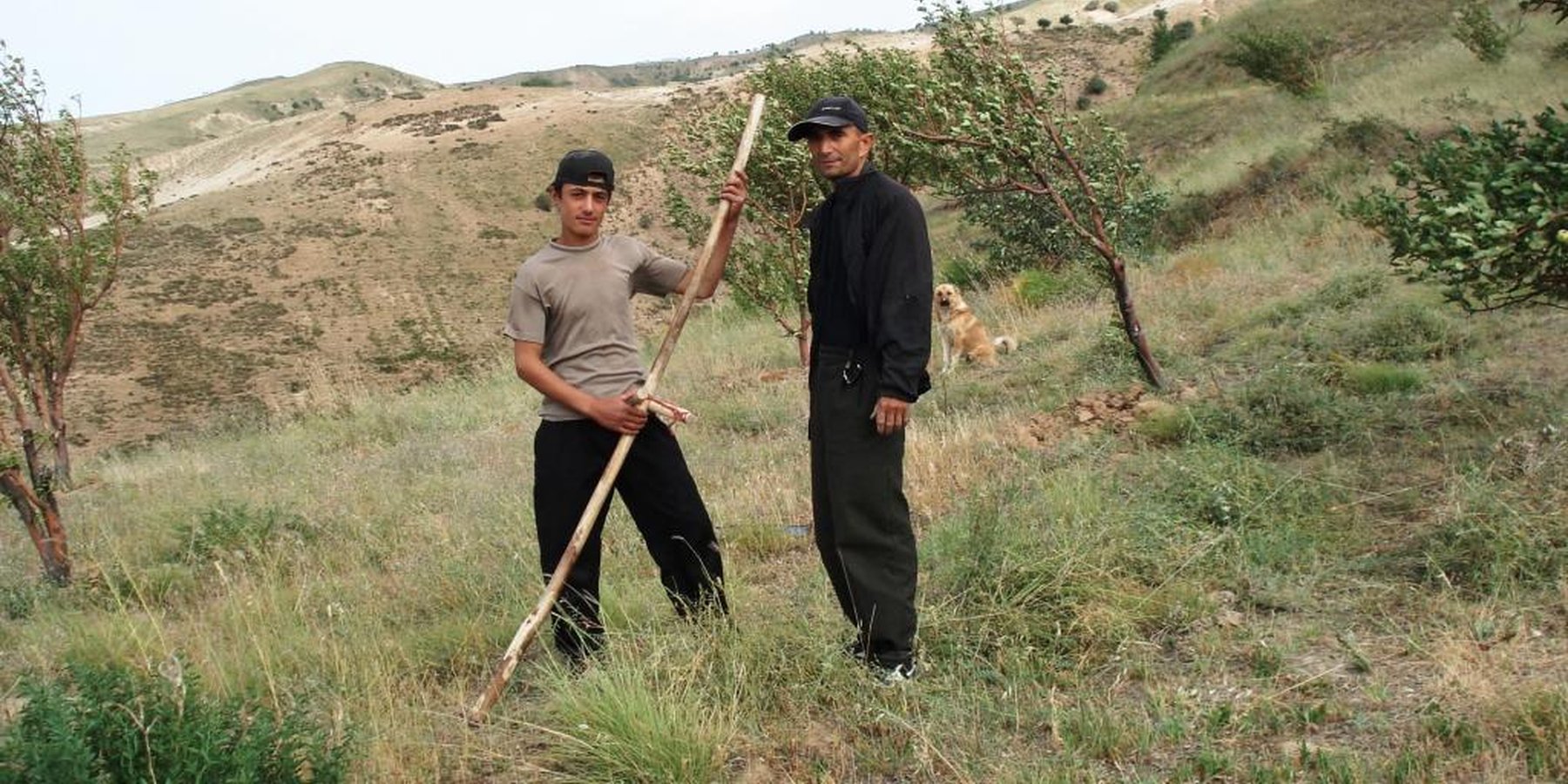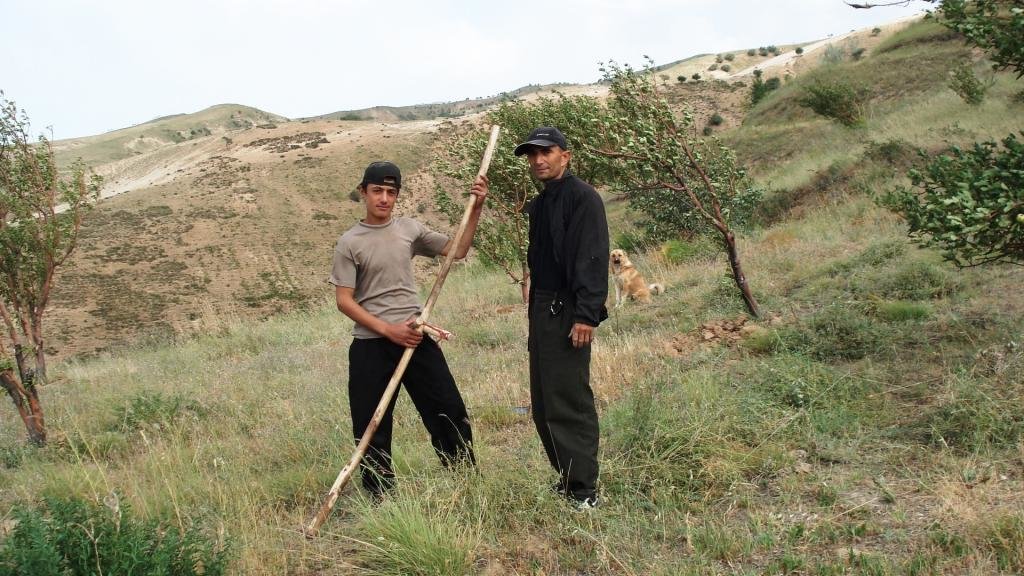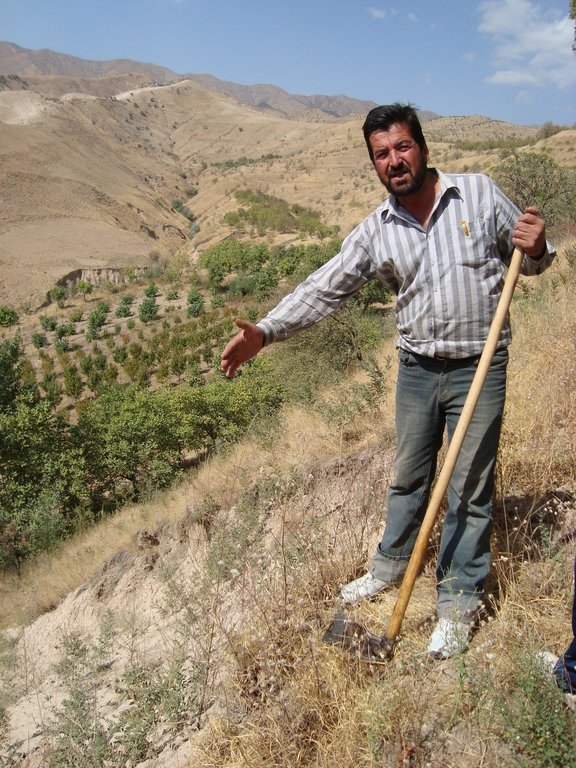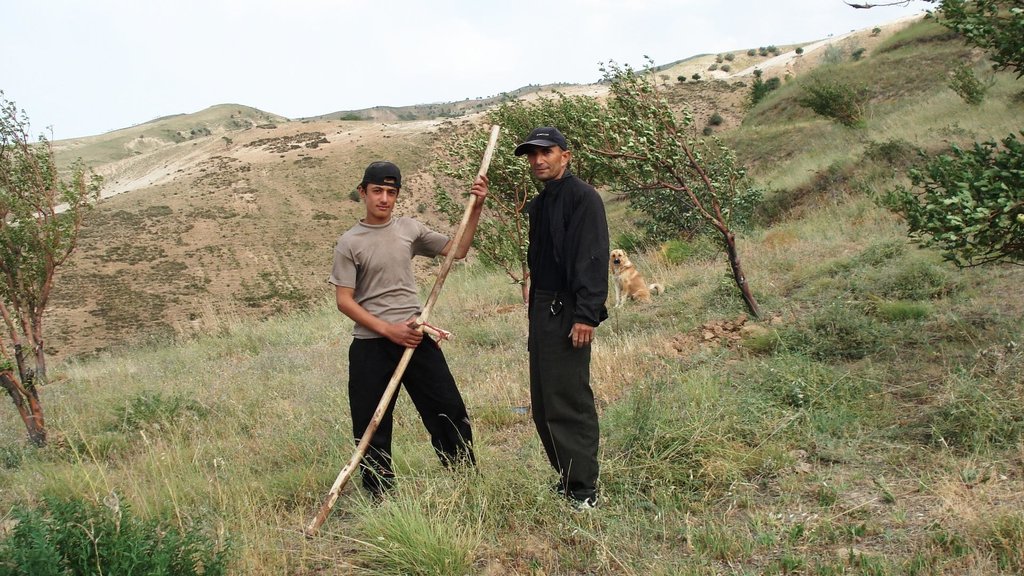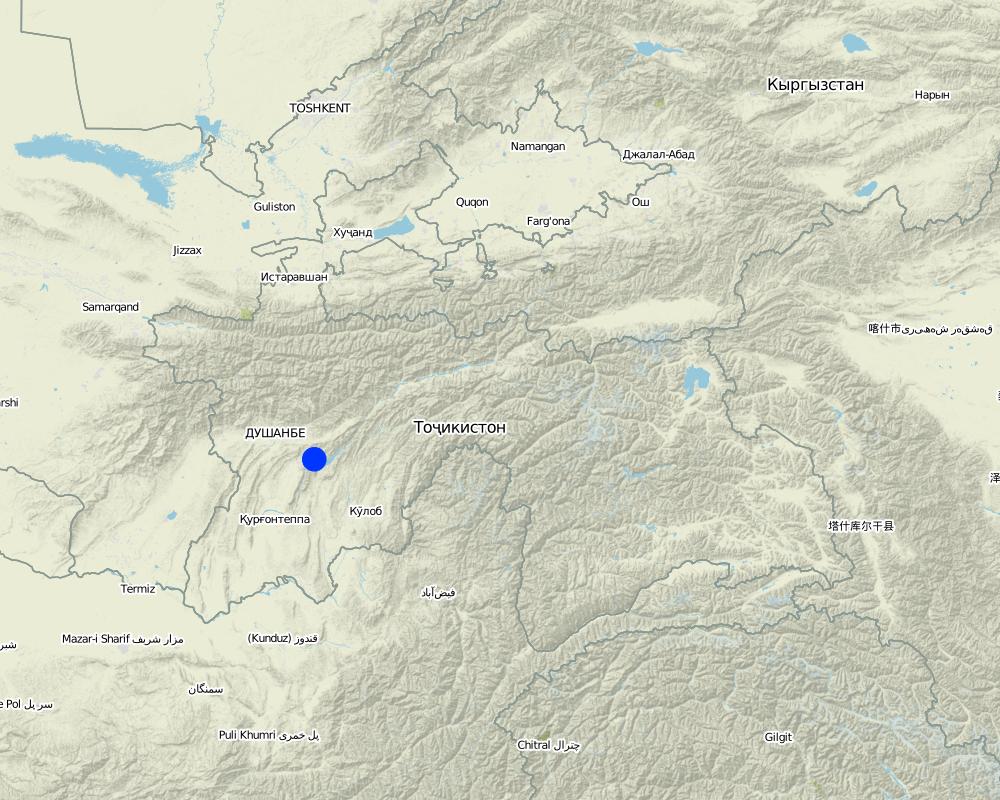State-controlled research territory for orcharding [طاجيكستان]
- تاريخ الإنشاء:
- تحديث:
- جامع المعلومات: Christian Wirz
- المحرر: –
- المُراجع: David Streiff
approaches_2566 - طاجيكستان
عرض الأقسام
توسيع الكل طي الكل1. معلومات عامة
1.2 تفاصيل الاتصال بالأشخاص الرئيسيين لمصدر المعلومات والمؤسسات المعنية بتقييم وتوثيق النهج
اسم المؤسسة (المؤسسات) التي سهلت توثيق/تقييم النهج (إذا كان ذلك على صلة)
CDE Centre for Development and Environment (CDE Centre for Development and Environment) - سويسرا1.3 الشروط المتعلقة باستخدام البيانات الموثقة من خلال WOCAT
متى تم تجميع البيانات (ميدانيا)؟:
20/08/2008
يوافق جامع المعلومات والشخص (لاشخاص) الرئيسي لمصدر المعلومات على الشروط المتعلقة باستخدام البيانات الموثقة من خلال WOCAT:
نعم
1.4 المراجع الخاصة باستبيان(استبيانات) تقنيات الإدارة المستدامة للأراضي

Combined cut-and-carry and fruit-production system with terraces [طاجيكستان]
A combination of fruit- and nut-trees together with seminatural trees and shrubs on one side with grass-communities on the other side provide for a diversified production system.
- جامع المعلومات: Christian Wirz
2. وصف نهج الإدارة المستدامة للأراضي
2.1 وصف موجز للنهج
Cultivation of an orchard with research activities and research staff with food for work.
2.2 وصف تفصيلي للنهج
وصف تفصيلي للنهج:
Aims / objectives: The main objective is to dispose of varieties of fruits that are adapted to different conditions. Another objective is to prevent degradation and test methods of rehabilitation and to spread this knowledge. The orchard was also implemented as a source of labour for 50 employees. In the last years it has become more important to acquire self-sufficiency by fruit- and hay-production, because wages cannot always be paid. And because of limited state-support in terms of fertilisers, pesticides and machines, the selling of tree saplings is important.
Methods: Work is subdivided into research, whereby the analysis of soils is carried out in laboratories, into conservation methods carried out by field staff and the brigadier himself (planting fruit and other trees, grafting fruit trees, planting and maintaining tree saplings, combatting pests and forbs) and harvest (of fruits and hay) that is carried out by all the employees and their families. The fruits are partly dried and sold.
Stages of implementation: After the terraces being built and the trees being planted in the early 1960ies, the orchard needed to be maintained: e.g. annually trees are substituted and fertilisers, manure and pesticides are applied. When trees are not grown, intercropping is possible. Since 1992 soils on the terraces, between the trees, are not tilled anymore, because rees are too high.
Role of stakeholders: The workers are initially employed for a clearly defined work such as tractor driver, research coordinator or research scientist. They execute orders given by their superiors. In the years after independance the strict subdivision is broken up and the research station is more independent. During civil war, when the district government was nearly inexistant, the land needed to be distributed among the employees, who were now land rentors and had to maintain their part of the orchard by themselves: It was the only way to protect the orchard from being destroyed, says the research coordinator.
2.3 صور عن النهج
2.5 البلد/المنطقة/المواقع التي تم تطبيق النهج فيها
البلد:
طاجيكستان
المنطقة/الولاية/المحافظة:
Region of Republican Subordination
مزيد من التفاصيل حول الموقع:
Faizobod
التعليقات:
The research area is subdivided into two parts, one in the higher hills (around 1800-1900m) and one close to the village Karsang. Only the latter is assessed, even if the applied technology and the approach are similar for both locations.
Map
×2.6 تواريخ بدء وإنهاء تنفيذ النهج
أشر إلى سنة البدء:
1965
2.7 نوع النهج
- قائم على مشروع/برنامج
2.8 الغايات/الأهداف الرئيسية للنهج
The Approach focused mainly on SLM with other activities (In the last years production (of fruits and young trees) for market and self-sufficiency has increased.)
The field station should elaborate knowledge on fruit-production in steep areas. The knowledge gained on terraces would also be useful in the 1970ies, when forest administration was implemented and started to adopt and adapt the terrace technology. Research was in cooperation with other regions of Tajikistan and the URSS, e.g. good walnut varieties from Ukraine were imported and bred to make them adapted to local climate. From the very beginning it was important integrate and to create a surplus value for local population, be it jobs or knowledge on erosion prevention and fruit-production. In the last years it has become more important to spread conservation and production knowledge in favour of local population: Workshops are regularly organised, together with NGOs and with the own specialists, to make population share the gained knowlegde and apply it in their own orchards.
The SLM Approach addressed the following problems: The main focus was research on the productivity and stress-resistance (e.g. droughts) of different varieties of fruit-trees and vines under different climatic conditions. Another important objective is the elaboration of efficient terrace technology against erosion.There were also particular interests of political leaders such as vineyards for wine-production, a factor that is not important anymore in a country where the Islamic religion seems to be more important today than in Soviet times.
2.9 الظروف التي تمكن أو تعيق تنفيذ التقنية/التقنيات المطبقة بموجب النهج
الإطار القانوني (حيازة الأراضي، وحقوق استخدام الأراضي والمياه)
- تمكين/تمكيني
The existing land ownership, land use rights / water rights greatly helped the approach implementation: Land belonged to the state in former USSR and the state initiated the project.
المعرفة حول الإدارة المستدامة للأراضي، والوصول إلى الدعم الفني
- معيق
Topography (very steep slopes) difficult for mechanical use and dangerous for tractor drivers.
Treatment through the SLM Approach: Terraces reduce slope and besides being a better wind-protection planting the trees diagonally to the main slope direction is a
3. المشاركة وأدوار الأطراف المعنية
3.1 أصحاب المصلحة المعنيون بالنهج وأدوارهم
- مستخدمو الأراضي المحليون/المجتمعات المحلية
Women are considered to be responsible for work in the household, even if they are sometimes the main field-workers today
- متخصصون في الإدارة المستدامة للأراضي / مستشارون زراعيون
by SLM specialists alone (top-down): Implementation and control of implementation. They are also encharged of research.
- الحكومة الوطنية (المخططون، صانعو القرار)
According to national and Soviet agricultural policies, the orchard was designed and organised.
Decision to implement research station (Academy of Science)
No women are found in a leading position of this research station.
3.2 انخراط مستخدمي الأراضي المحليين/المجتمعات المحلية في المراحل المختلفة للنهج
| انخراط مستخدمي الأراضي المحليين/المجتمعات المحلية | حدد من شارك وصف الأنشطة | |
|---|---|---|
| المبادرة/التحفيز | غير موجود | |
| التخطيط | غير موجود | |
| التنفيذ | سلبي | Tractor-driver for terraces and field staff for tree-planting, land users' families for harvesting. |
| الرصد/التقييم | غير موجود | |
| Research | غير موجود |
3.4 اتخاذ القرار بشأن اختيار تقنية/تقنيات الإدارة المستدامة للأراضي
حدد من الذي قرر اختيار التقنية/التقنيات التي سيتم تنفيذها:
- متخصصون في الإدارة المستدامة للأراضي بمفردهم
اشرح:
Different experts are the decision-makers, depending on the problem (e.g. type of fruits). This has stayed till today.
Decisions on the method of implementing the SLM Technology were made by by SLM specialists alone (top-down)
4. الدعم الفني وبناء القدرات وإدارة المعرفة
4.1 بناء القدرات/التدريب
هل تم تقديم التدريب لمستخدمي الأراضي / الأطراف المعنيين الآخرين؟:
نعم
حدد من تم تدريبه:
- مستخدمو الأراضي
- موظفون ميدانيون/ مستشارون
شكل التدريب:
- مناطق العرض
المواضيع المغطاة:
For land users it is interesting to learn specific technologies in fruit-production, e.g. how walnut saplings are maintained. For field staff it is interesting to learn from specialists how something is explained to different participants (young, old).
4.2 خدمة استشارية
هل يملك مستخدمو الأراضي وصولا إلى خدمة استشارية؟:
كلا
4.3 تعزيز المؤسسات (التطوير التنظيمي)
هل تم إنشاء أو تعزيز مؤسسات من خلال هذا النهج؟:
- لا
4.4 الرصد والتقييم
هل يشكل الرصد والتقييم جزءا من النهج؟:
نعم
التعليقات:
bio-physical aspects were regular monitored by project staff through observations; indicators: Stress-resistance, depending on climate
economic / production aspects were regular monitored by project staff through measurements; indicators: Fruit harvest per tree.
There were few changes in the Technology as a result of monitoring and evaluation: With reduced crop harvests, partly due to lacking irrigation and partly to tall trees, cropping was stopped. Instead haymaking was focused.
5. التمويل والدعم المادي الخارجي
5.1 الميزانية السنوية لمكون الإدارة المستدامة للأراضي في النهج المذكور
التعليقات (على سبيل المثال المصادر الرئيسية للتمويل/الجهات المانحة الرئيسية):
Approach costs were met by the following donors: government (In the past government paid): 100.0%
5.2 الدعم المالي/المادي المقدم لمستخدمي الأراضي
هل حصل مستخدمو الأراضي على دعم مالي/ مادي لتنفيذ التقنية/ التقنيات؟:
كلا
5.3 إعانات لمدخلات محددة (بما في ذلك العمالة)
- معدات
| حدد المدخلات التي تم دعمها | إلى أي مدى | حدد الإعانات |
|---|---|---|
| الآلات | ||
- زراعة
| حدد المدخلات التي تم دعمها | إلى أي مدى | حدد الإعانات |
|---|---|---|
| بذور | ||
| أسمدة | ||
إذا كان العمل من قبل مستخدمي الأراضي مدخلاً جوهريًا، فهل كان:
- الغذاء مقابل العمل
التعليقات:
There are fix employees with monthly salaries. But often, instead of salaries, people are paid in kind (i.e. the fruits for own use are substracted from the salary).
The government paid the whole implementation of the technology.
5.5 حوافز أو وسائل أخرى
هل تم استخدام حوافز أو أدوات أخرى لتشجيع تنفيذ تقنيات الإدارة المستدامة للأراضي؟:
كلا
6. تحليل الأثر والتصريحات الختامية
6.1 آثار النهج
هل ساعد النهج مستخدمي الأراضي على تنفيذ وصيانة تقنيات الإدارة المستدامة للأراضي؟:
- لا
- نعم، قليلا
- نعم، باعتدال
- نعم، إلى حد كبير
Cover recovered on a nearby ex-cropland area, where the orchard technology was applied. It is especially the grazing-stop that triggered the change.
Did other land users / projects adopt the Approach?
- لا
- نعم، قليلا
- نعم، باعتدال
- نعم، إلى حد كبير
In the 1970s the forest department began with state-organised reforesting and terracing. Nowadays land users visiting workshops in the research station adopt the orchard technology, but just for self-sufficiency.
Did the Approach lead to improved livelihoods / human well-being?
- لا
- نعم، قليلا
- نعم، باعتدال
- نعم، إلى حد كبير
Especially the employees could profit from their job, be it by payments in kind or by the wages. During civil war the decision to leave the cultivation of the orchards to local land users did not only
Did the Approach help to alleviate poverty?
- لا
- نعم، قليلا
- نعم، باعتدال
- نعم، إلى حد كبير
The salaries allowed some land users to buy private livestock.
6.2 المحفز الرئيسي لقيام مستخدمي الأراضي بتنفيذ الإدارة المستدامة للأراضي
- زيادة الإنتاج
Especially in recent years workers have been relying more and more on harvests (fruits, hay).
- الوجاهة والضغط الاجتماعي/التماسك الاجتماعي
The employees made their living with this job.
- الوعي البيئي
The brigadier was and is convinced that the ecosystem is maintained by the whole project.
6.3 استدامة أنشطة النهج
هل يمكن لمستخدمي الأراضي المحافظة على استدامة ما تم تنفيذه من خلال النهج (بدون دعم خارجي)؟:
- غير مؤكد
إذا كان الجواب لا أو غير متأكد، حدد ذلك وعلق عليه:
Already today organisations carrying out workshops or training activities are asked to pay for it: food, paper and pens for the participants have to be organised.
6.4 نقاط قوة/مزايا النهج
| نقاط القوة/ المزايا/ الفرص من وجهة نظر مستخدمي الأراضي |
|---|
| The strong focus on research helps improve the orchard. (How to sustain/ enhance this strength: Inputs from external experts (from Switzerland) could help improve the technology.) |
| نقاط القوة/ المزايا/ الفرص من وجهة نظر جامع المعلومات أو غيره من الاشخاص الرئيسيين لمصدر المعلومات |
|---|
| It helps spread knowledge on an efficient conservation technology, especially on tree planting. |
| It permits land users to learn conservation methods and to make their living at the same time. (How to sustain/ enhance this strength: Giving the land users more decision capacities might strengthen their will to implement conservation.) |
6.5 نقاط الضعف/ العيوب في المنهج وطرق التغلب عليها
| نقاط الضعف/ المساوىء/ المخاطر من وجهة نظر مستخدم الأراضي | كيف يمكن التغلب عليها؟ |
|---|---|
| The chaos of war could have destroyed the orchard (people chopping trees illegally in a situation of no control). | The possibility of employees to rent land (land tenure assured) was the only possibility to save the orchard (as soon as the harvest goes to the land user, he has more interest to improve the land use). |
| نقاط الضعف/ المساوىء/ المخاطر من وجهة نظر جامع المعلومات أو غيره من الاشخاص الرئيسيين لمصدر المعلومات | كيف يمكن التغلب عليها؟ |
|---|---|
| Research activities and the improvement of conservation technologies depend very much on the research coordinator. | Strengthening the position of land users would help make the system more sustainable on the long-term |
الروابط والوحدات المواضيعية
توسيع الكل طي الكلالروابط

Combined cut-and-carry and fruit-production system with terraces [طاجيكستان]
A combination of fruit- and nut-trees together with seminatural trees and shrubs on one side with grass-communities on the other side provide for a diversified production system.
- جامع المعلومات: Christian Wirz
الوحدات المواضيعية
لا يوجد وحدات مواضيعية


